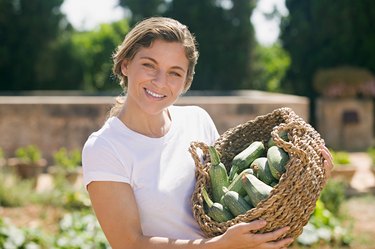
Minimal rainfall, hot temperatures and desert conditions don't have to stand between you and the vegetable garden of your dreams. A successful Las Vegas vegetable garden requires planning around the growing conditions in the area. Most of Las Vegas falls in U.S. Department of Agriculture plant hardiness zone 8b, which means that extreme heat in summer and possible frost in winter make spring and fall the best times to grow your vegetables. The desert soil and sun also affect your plants, so understanding how to make the location work for you is the first step toward a bountiful harvest.
Soil Concerns
Video of the Day
Las Vegas soil tends to have a high pH, or alkalinity, and high salt content, which make successful gardening in native soil difficult. Compaction and lack of organic matter are also problems. Bringing in better soil and working in thick 4- to 6-inch layers of compost can help improve the soil. Raised garden beds filled with well-drained soil that's rich in organic matter provide another option for successful vegetable growing in Las Vegas. If neither of these options works for your budget or space, you can also grow most vegetables in containers.
Video of the Day
Planting Time
Chances are the planting dates on the back of the seed packet won't match up with the best growing season in the desert Southwest. Cool-season vegetables, including leafy greens, peas (Pisum sativum) and broccoli (Brassica oleracea), require planting in early February so they have time to grow, mature and produce before the heat of the desert summer causes them to wither or go to seed. You can also plant cool-season vegetables as a fall or winter crop in late August through September. Get warm-season vegetables, such as tomatoes (Solanum lycopersicum) or beans (Phaseolus vulgaris), in the ground in late March, April or early May. This gives the plants time to reach maturity before the heat of summer causes temporary dormancy.
Sun and Heat
Although most garden vegetables require full, all-day sunlight in milder climates, in the desert you may need to plant so your vegetables receive some shade protection during the hottest part of the day. The intensity of the sun on a hot day can cause rapid water loss in plants, resulting in wilt or even premature death. Most warm-weather vegetables stop producing when temperatures rise above 95 degrees Fahrenheit, a period that can last two months or longer in Las Vegas. Providing some shade and sufficient water keeps the plants alive so they will resume production as the temperatures begin to cool in the fall. For example, you may get one or two harvests from your tomato plants in June, nothing in July and August, and another crop or two in September and October.
Wise Watering
Water is a precious resource in the desert garden, and most vegetable plants aren't well-suited to dry conditions. A drip irrigation system provides water directly to the soil where it's most needed, with only a minimal amount lost to evaporation. Installing the irrigation lines beneath plastic mulch further minimizes water loss and allows the moisture to soak in deeply to the roots. Plastic mulch does cause the soil to heat up, however, which can also stress plants. Covering the mulch with a thin layer of straw helps to reflect the sunlight, resulting in cooler soil and healthier plants. Most vegetables require 1 to 2 inches of water weekly, although they may require more during exceptionally hot weather. Monitor your plants' health and adjust your irrigation system as needed.
Problem Pests
Common garden pests in Las Vegas include soft-bodied pests that feed on plant sap, such as aphids and spider mites, as well as some beetle pests, such as the Colorado potato beetle. Wash aphids and spider mites off your plants by spraying both sides of the leaves with a forceful stream of water as often as needed. To control beetle infestations, an article published by the Oklahoma Cooperative Extension Service suggests using row covers early in the growing season when plants are young and tender, along with handpicking and destroying the adults and egg masses.
- University of Nevada Cooperative Extension: Grow Your Own: Weekly Steps to a Great Vegetable Garden
- University of Nevada Cooperative Extension: Becoming a Desert Gardener
- University of Nevada Integrated Pest Management: Beat What's Pestering Your Plants
- Moon Valley Nursery: Top 10 Bad Bugs for Your Garden
- University of Missouri Extension: Aphids, Scales and Mites on Home Garden and Landscape Plants
- Oklahoma Cooperative Extension Service: Home Vegetable Garden Insect Pest Control
- University of Texas at Austin - Ask Mr. Smarty Plants: Vine for Full Sun in Las Vegas, NV